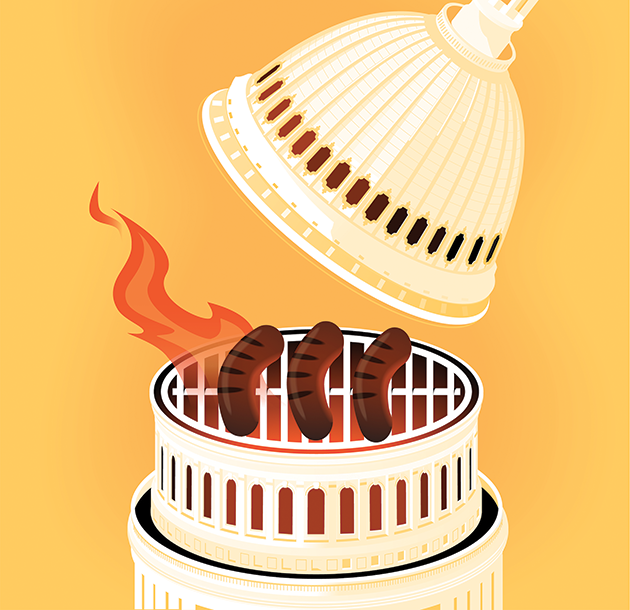
Earlier this year, California Gov. Jerry Brown faced a problem. He wanted to raise the state gasoline tax by 12 cents a gallon to fund new spending on roads, bridges, and mass transit, but in California tax increases require a two-thirds vote of the Legislature. Republicans, naturally, were all opposed. Democrats have a bare two-thirds majority on their own, so the loss of even one Democrat in the state Senate would have doomed Brown’s proposal.
In the end, one of those Democrats bolted, but the bill passed anyway thanks to some good ol’ traditional dealmaking. Party leaders agreed to earmark $427 million to the districts of wavering Democrats, as well as $500 million to pick up the one Republican vote they needed. “At the end of the day, I asked for certain things and they delivered them, so I needed to vote for it,” Republican Sen. Anthony Cannella explained afterward.
If something similar had played out in Congress, the bill would have failed. That’s not because Congress is more partisan than California’s Legislature. It’s because party leaders in Congress have no way of persuading members—bribing them, if you prefer—to cross the aisle if it turns out they’re a vote or two shy on a bill. Republicans banned earmarks following the 2010 midterm elections, and shortly after that President Barack Obama jumped on the bandwagon, saying he’d veto any bill that included earmarks. Democrats caved a few days later, and with that earmarks were officially gone.
An earmark is a simple thing: It’s just a sentence in a spending bill that directs money to a specific project at the request of a member of Congress. In their most innocent form, earmarks are a way to give legislators a say in how money is used in their districts. In their ugliest form, they’re straight-up bribes designed to wheedle legislators into voting for measures they’d otherwise oppose. Either way, they’ve been around for a long time. The first known earmark in American history was contained in the Lighthouses Act of 1789, passed a mere five months after the first meeting of Congress. In order to gain the votes of reluctant Southerners, party leaders promised them a new lighthouse in Virginia. They voted for the bill.
Did America really need that lighthouse? Maybe not, but it got the job done. This is the seamy side of earmarks, and it’s the reason they’ve been a longtime target of good-government groups, whose opposition grew stronger as the number of earmarks in the federal budget exploded. The advocacy group Citizens Against Government Waste has been tracking earmarks since 1991 in its annual Pig Book, and that year it counted about 553 earmarks worth $3.1 billion. By 2005, that had skyrocketed to almost 14,000 earmarks worth $27.3 billion. A campaign to encourage transparency in earmarks had a temporary chastening effect, but it didn’t last long. After declining sharply in 2007, earmarks began to rise again.
Then Sarah Palin came under attack for supporting the infamous Bridge to Nowhere, a roughly $350 million project linking Alaska’s Ketchikan region (population 14,070) to an airport on Gravina Island. Suddenly earmarks went from an obscure Capitol Hill obsession to a public menace. After the election, the tea party movement began pressuring Republicans to ban earmarks, and in 2010 they finally did.
But was it a good idea?
The argument against earmarks appears straightforward: It’s unseemly to trade money for votes. And earmarks can be even worse than that. They give members of Congress the ability to steer spending to firms that then turn around and provide them with kickbacks. Rep. Randy “Duke” Cunningham went to prison in 2006 for directing defense earmarks to firms that bribed him with money for a condo, free use of a yacht, and other goodies. Three years later, seven members of Congress were accused of trading earmarks for campaign contributions as part of a defense lobbying scandal. Although they were officially cleared of wrongdoing, the final report of the Office of Congressional Ethics made it clear the lobbyists targeting them had acted in a pretty shady way.
But pragmatists see earmarks differently. It’s telling that longtime Washington insiders like Sens. Harry Reid and Mitch McConnell were the ones who resisted the earmark ban most vigorously. Among the top party leaders, then-Republican Speaker John Boehner—whose first congressional campaign attacked the obscure earmarks—was alone in leading the charge against them.
It’s not hard to guess why. Party leaders are the ones responsible for wrangling enough votes to pass big, complicated bills. To do that, they need to be willing to pressure members for votes any way they can. Offering a wavering member a freeway on-ramp or a senior center in her district may not be the most important bit of leverage they have, but sometimes it’s enough to get the final few votes they need to cross the finish line. Is this unseemly? Maybe, but former Senate Majority Leader Tom Daschle thinks the earmark system was a net positive anyway: “It wasn’t pretty,” he admitted in 2014, “but it worked.”
Here’s another dirty secret: Earmarks don’t actually cost anything. Overall spending levels are set by Congress in appropriations bills, and bureaucratic formulas decide how much money goes to each state. Earmarks merely redirect some of that spending; they don’t add to it.
That’s why the tea party rose against them. As they see it, earmarks reduce opposition to big spending bills and indirectly produce a steady upward ratchet in federal expenditures. The only way to maintain pressure to reduce federal spending is to change the incentives in Congress. “I had to get them out of the transactional, day-to-day ‘who can do what for me,'” Boehner explained. “I had to get them to think on a higher plane.”
So how did that higher plane work out? The earmark ban went into effect in early 2011. Within a few months, with the budget for 2012 going nowhere, Republican legislators touched off a debt ceiling crisis that nearly crippled the country. With Democrats and Republicans at loggerheads—and no agreement in sight—Congress finally passed the Budget Control Act of 2011, which kicked the can down the road. The BCA created automatic spending cuts for both domestic and military programs if no further agreement was reached, and in theory this was supposed to be a result so dire that it would force cooperation on a budget.
It didn’t. To everyone’s dismay—aside from jubilant tea partiers—the automatic spending cuts went into effect. Then, after a brief pause for the 2012 election, Republicans forced yet another debt ceiling crisis in 2013. The federal budget has been an ongoing soap opera ever since, and even Boehner admitted that the earmark ban made his life harder. “It’s not like the old days,” he said in 2011, when he was still speaker of the House. “Without earmarks to offer, it’s hard to herd the cats.”
Jeffrey Lazarus, a political scientist at Georgia State University, agrees. A few years after the earmark ban took effect, he told the Boston Globe, “What we’re seeing is a natural experiment where we say, ‘Let’s try to run Congress without earmarks for a few years.’ And what we’re finding out is that we don’t really like what’s going on.” With federal budgeting reduced to a pure battle of ideologies, there’s less opportunity for compromise and less downside to a budget not being passed. After all, it’s not going to contain any goodies for your district, so who cares?
This is fundamentally the argument in favor of earmarks. It’s the liberal argument, anyway: Purists on both sides hate the idea of legalized back-scratching that helps perpetuate the mushy status quo. And earmarks generally favor the majority’s leaders in power, so Democrats might be skittish to reintroduce them now (though they could undercut the Freedom Caucus). But all that aside, people favor a government that works. Unseemly or not, earmarks are a small price to pay to keep the government humming along and helping people in an efficient and predictable way.
But there’s a strong conservative argument in favor of them, too. Without earmarks, spending decisions are made by the federal bureaucracy in Washington, DC. As former Rep. Steve LaTourette colorfully put it, “Do we really believe that the same bureaucrats responsible for the Veterans Affairs scandal, the disastrous health care rollout, and the IRS targeting of political opponents should be given 100 percent control over where federal dollars are allocated?”
More generally, earmarks shift power from the executive branch to Congress, something that conservatives favor. Conservatives also favor pushing spending decisions down to the local level, and members of Congress are the ones elected to represent their districts and their states. As long as earmarks are transparent—that is, everyone knows who asked for each earmark and how much it’s for—why shouldn’t Congress have some say in how money is spent?
And there’s another reason to be skeptical of the earmark ban: It hasn’t really worked. Roll Call columnist Patricia Murphy explains, “One of the greatest ironies of Congress’ earmark ban is that earmarks still haven’t gone away. The few that remain have simply gone underground.”
Sure enough, the Pig Book didn’t go out of business in 2011. Its most recent edition claims that earmarks increased from zero in 2011 to $5.1 billion in 2016. At that rate, in about a decade earmarks will once again hit their 2010 mark of $16.5 billion.
What’s worse, although the number of earmarks has decreased, the average size of each earmark has skyrocketed. And no one knows where they come from. “There are no names of legislators, no list or chart of earmarks, and limited information on where and how the money will be spent,” according to Citizens Against Government Waste. “Earmarks were scattered throughout the legislative and report language, requiring substantial detective work to unearth each project. While the lower number and cost of earmarks are an improvement relative to many prior years, transparency and accountability have regressed immeasurably.”
So what’s the answer? A couple of years ago, writer Jonathan Allen—once a foe of earmarks—suggested that, like capitalism, earmarks worked well only if they were regulated. He proposed a complicated set of rules that capped earmark spending and allocated it evenly to all members of Congress—but that stripped out all the earmarks from any member who voted against the final appropriations bill. The pool of money from the rejected earmarks would then be reallocated, with some of it going to party leaders who could use it to bargain for votes later.
Is this the answer? Or has partisanship gotten so intense that bringing back earmarks would do no more good than duct tape on the Titanic? There’s only one way to find out.

















